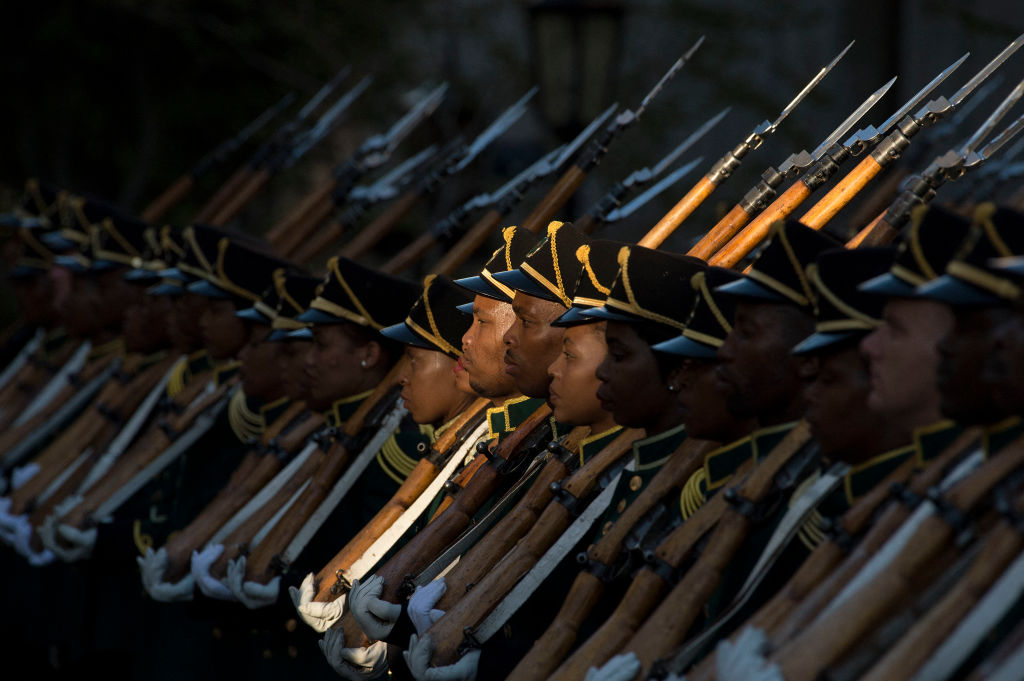ADF STAFF
Thirty years after its founding, the South African National Defence Force (SANDF) finds its historic role as a peacekeeping group on the continent increasingly limited by financial constraints that may force leaders to rethink their mission.
With 70,000 service members, about half of them in the land forces, the SANDF ranks among Africa’s largest militaries. Since the force was reconstituted at the end of the apartheid era, South Africa’s political leaders have called upon it for an array of assignments, from international training and peacekeeping missions to domestic law-and-order activities.
Those missions continue with a budget that has dwindled from 1.5% of South Africa’s gross domestic product to about 0.8%, according to Darren Olivier, director of African Defense Review. The current defense budget of $2.7 billion is expected to rise in the coming years, but not enough to keep up with inflation running around 5%.
“What you have is, the budget has shrunk relative to inflation and the economy. Meanwhile the cost of the SANDF in terms of fuel, personnel, and everything else has gone up,” Olivier told eNCA television. “You simply can’t run a military the size of the SANDF on the current budget.”
Observers say the steady reduction in funding has put the SANDF into a state of decline. The problem has become so pronounced that Defense Minister Thandi Modise told Parliament in July 2023 that the military’s readiness was becoming “unsustainable.”
“We have now reached the point where the republic must decide on the kind of defense force it wants and what it can afford,” Modise wrote in her report to Parliament.
The readiness of South Africa’s military has been debated after the recent deployment of nearly 3,000 Soldiers as part of a Southern Africa Development Community (SADC) mission against M23 terrorists in the eastern Democratic Republic of the Congo (DRC). The mission deployed without air cover because eight of South Africa’s 11 Denel Rooivalk attack helicopters have been grounded due to a lack of funds to maintain them. The remaining three can fly with restrictions, according to defense officials.
In addition, the nation’s Oryx transport helicopters, which have been deployed as part of the United Nations mission in the DRC, face similar maintenance issues.
Modise said in October 2023 — two months before the SADC mission to the DRC — that only five of the country’s 39 Oryx helicopters were functional. The country needed to spend $132 million to put the remainder back into service, she said.
“Air assets are absolutely critical in any counterinsurgency operation, particularly in this terrain,” Piers Pigou, Southern Africa program head at the Pretoria-based Institute for Security Studies, recently told BizNews. “We have put our hand up for something we aren’t able to deliver.”
South Africa’s restricted defense budget has caused ripple effects at Denel, which has lost enough skilled personnel to put several major projects so far behind schedule that they are effectively as outdated as they equipment they were designed to replace, according to Armscor, the SANDF’s procurement arm.
The SANDF’s increasing use of reserve forces to boost staffing of its missions has pushed the defense budget more than $150 million into the red on salaries — a situation that is likely to worsen with more cuts to the defense budget on the horizon.
Defense expert Helmoed Heitman told News24 that South Africa’s forces are stretched so thin that the country’s national security could be at risk.
“The army does not have enough troops to go everywhere,” Heitman said. “It’s got troops in Mozambique, in the DRC, plus they do work on the border. Then every now and then they get called out to do work locally. They just don’t have enough bodies to do the work.”
Speaking to eNCA, Olivier called for more consistency in the defense budget to allow for long-term planning. In the meantime, the SANDF’s budget would have to double for the military to meet the current demands being placed on it, he said.
“That’s not realistic,” he added. “So, the answer then becomes ‘What do we lose? What do we give up?’ Ultimately, we need a new defense review — something to completely re-examine what the role of defense is in the country.”

